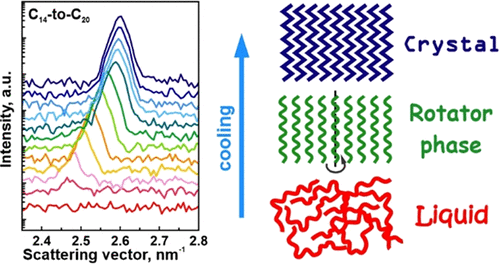Structure of rotator phases formed in C13-C21 alkanes and their mixtures: in bulk and in emulsion drops

Crystallization of alkane mixtures has been studied extensively for decades. However, the majority of the available data consider the behavior of alkanes with chain length of 21 C atoms or more. Furthermore, important information about the changes of the unit cell structure with the temperature is practically absent. In this work, the phase behavior of several pure alkanes CnH2n+2, with n ranging between 13 and 21, and their binary, ternary, or multicomponent equimolar mixtures are investigated by X-ray scattering techniques. Both bulk alkanes and oil-in-water emulsions of the same alkanes were studied. The obtained results show the formation of mixed rotator phases for all systems with chain length difference between the neighboring alkanes of Δn ≤ 3. Partial demixing is observed when Δn = 4, yet the main fraction of the alkane molecules arranges in a mixed rotator phase in these samples. This demixing is suppressed if an alkane with an intermediate chain length is added to the mixture. Interestingly, a steep temperature dependence of the interlamellar spacing in mixed rotator phases was observed upon cooling to temperatures down to 10 °C below the melting temperature of the mixture. The volumetric coefficient of thermal expansion of the rotator phases of mixed alkanes (αV ≈ 2 × 10-3 °C-1) is around 10 times bigger compared to that of the rotator phases of pure alkanes. The experiments performed with emulsion drops containing the same alkane mixture while stabilized by different surfactants showed that the surfactant template also affects the final lattice spacing which is observed at low temperatures. In contrast, no such dependence was observed for drops stabilized by the same surfactant while having different initial diameters; in this case, only the initial temperature of the crystallization onset was affected.

